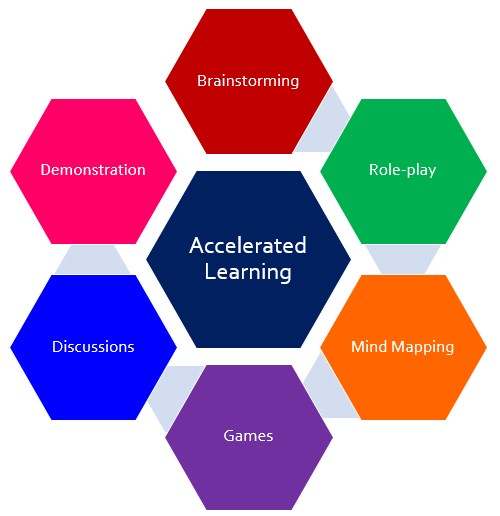Accelerated Learning Delivery Methods
Accelerated learning techniques provide the opportunity to deliver information more effectively and efficiently. Delivery methods should be focused on learner involvement and should be activity based to help ensure learner engagement.
Key Elements for Developing Delivery Methods for Accelerated Learning
- Develop a learner-centered approach
- Develop activities that involve the learner in the learning process
- Create presentations that are multisensory and multi-dimensional
- Develop presentations to reach a variety of different learning styles
- Change the pace and teaching style every 20 minutes
- Create activities that promote collaboration amongst learners
- Incorporate mental imagery and visual effects
Effective Delivery Methods
Learner-centered Approach
When creating delivery methods, a learner-centered approach should be developed, rather than teacher-centered approach. A learner-centered approach shifts the focus of instruction from the teacher to the learner, and puts the learner in direct control of what they are learning. This approach is based on the constructivist learning theory that emphasizes the learner’s instrumental role in constructing meaning from new information and experiences. The theory is predicated on the principle that knowledge is not something a learner consumes or absorbs, but something a learner creates.
Active Learner Involvement
People learn best when they are actively involved in their learning. Learning is not a spectator sport, but a participatory one. Since knowledge is not something a learner passively absorbs, but something a learner actively creates delivery methods should be more activity-based rather than presentations-based. Give the learners some to do, and they will learn by doing.
Activities for Accelerated Learning
- Brainstorming
- Chalkboards/whiteboards with color
- Demonstration
- Field trips
- Videos
- Games
- Problem solving activities
- Mind-Mapping
- Charts
- Models
- Group discussions
- Debate
- Question & answer session
- Role-playing
- Storytelling
Various Methods
People have personal styles and preferences when it comes to learning something new. These preferences can be used to enhance the learning process for the individual. These different learning styles and different ways of processing information include visual, auditory, and kinesthetic. Therefore, develop methods that will allow each learner to exercise his or her preferred style. For example, create presentations that offer both visual and auditory elements to satisfy both preferences.
- Provide visual aids
- Incorporate videos
- Have field trips
- Create role-play activities
Multisensory and Multidimensional Approach
The brain is not a sequential processor, but a parallel processor. People do not simply learn by absorbing one thing at a time in linear fashion, but absorbing many things at once.
People learn best when they have a rich variety of learning options that allows them to use all their senses. Effective learning methods engages them on many levels simultaneously. Therefore, a multisensory and multidimensional approach that involves the whole mind and body should be employed for effective learning. Multisensory instruction can be accomplished by focusing on engaging the whole brain. This means the instruction and activities should engage the learner on all levels including intellectually, emotionally, as well as consciously and subconsciously.
- Use color
- Use visual effects
- Allow learners to walk about room
- Play games
Promote Collaboration
People generally learn better in a collaborative environment than a competitive one. A basic premise of accelerated learning is that all good learning tends to be social. People typically learn more by interacting with other than they learn by any other means.
Traditional learning emphasizes competition between isolated individuals. Competition between learners slows learning, while cooperation among learners speeds it.
- Have learners teach someone else what they are learning
- Have group discussions
- Allow debate of ideas
Create Concrete Images
Concrete images are much easier to grasp and retain than are verbal abstractions. That is why it is said; a picture is worth a thousand words. People typically remember visual images much easier and better than words. Using imagery can make learning more fun and effective.
- Have learners draw a picture
- Have learner use mind maps
- Use models or props
Summary
The following are suggestions for making the delivery of information more engaging:
- Allow collaborative group-based learning
- Have learners draw a picture
- Have learner use mind maps
- Use props and models
- Use color and visual aids
- Accommodate different learning styles
- Present material visually as well as verbally
- Provide a multidimensional approach
- Involve multiple senses
Links

